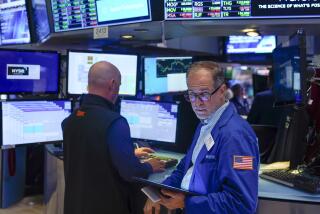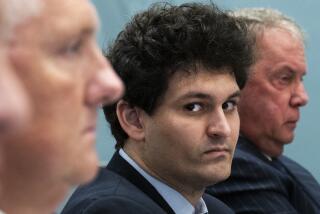Why Active Investing? Two Words: Things Change
- Share via
CHICAGO — On the stage in the Chicago Hilton’s ornate grand ballroom last Thursday sat four investment pros who would surely be included in any objectively chosen pantheon of legendary American money managers.
But these days on Wall Street, even legend status gets you only so much respect. From among the 600 or so attendees at this gathering--the annual mutual fund conference sponsored by fund tracker Morningstar--came a question that many of those in the audience might well have asked, if they hadn’t been mostly polite people.
How, queried a woman who identified herself as a financial planner, should she justify to her clients putting their money with even these fine stock managers, when the clients increasingly believe the smarter strategy might simply be to “index”--that is, to buy the entire market via a fund that replicates the performance of a major index such as the Standard & Poor’s 500 list of stocks.
On days like Thursday, with the blue-chip S&P; rocketing to new highs and once again leading the market overall--as it has with wild abandon since 1994--the concept of passive indexing seems particularly unassailable, almost a no-brainer.
You buy the market and forget about it. No highly paid fund manager to take 1% to 2% of your return each year in fees; no excessive trading of the portfolio, generating short- and long-term taxable capital gains that you don’t want; no worries about being in the wrong investment “style,” because when you index you essentially buy into, and hold, every style.
And, most important, no chance of earning less than the market return over the long term, which is exactly what two-thirds to three-quarters (depending on whose data you believe) of active fund managers will do, despite their best stock-picking efforts.
The planner’s question was hardly impertinent. In fact, it is totally pertinent in today’s market, as a growing number of mutual fund investors learn and ponder the idea of indexing. Yet at least initially, the four pros in the spotlight Thursday didn’t field the issue very well.
Martin J. Whitman, a sage among value-oriented investors and manager of the Third Avenue Value stock fund in New York, minced no words. The idea that active managers can’t outperform index funds is the drivel of theorists--”propaganda by [market] chartists who happen to have PhDs,” he snapped.
John H. Laporte, whose $4-billion-asset T. Rowe Price New Horizons fund is one of the country’s premier small-stock funds, basically pleaded befuddlement, calling the wide gulf between the performance of the S&P; 500 and the performance of most smaller stocks over the last 12 months “one of the most unusual divergences in the market that I have ever seen.”
As for Michael F. Price, head of Franklin Mutual Advisers and, like Whitman, a legend in the value-investing discipline, there was the seemingly arrogant response that “I am an anti-index fund” manager, and the admonishment that index funds “have nothing to do with [identifying] underlying values in companies.”
Unfortunately, all three of those answers missed the point. True, some fund managers will surely beat the index over time; true, it’s hard to understand precisely why smaller stocks are so badly lagging the S&P; of late; and true, index funds don’t try to find value in the market.
*
The main argument for indexing, however, derives from a straightforward cost-benefit analysis: that it just isn’t worth spending the time and energy trying to pick index-beating managers, or trying to decide between large and small stocks, or value stocks versus growth stocks, because in the long run the great majority of fund managers and investment styles can’t beat the return from buying and holding the market as a whole.
Indeed, even for the demigods on the Hilton ballroom dais, their 15-year track records for the most part only provide indexing zealots with more ammunition.
Through early this year, Laporte’s New Horizons fund lagged the S&P; 500 return over the prior 15 years by 2.5 percentage points annually, according to Morningstar data. Price’s Mutual Beacon fund lagged the S&P; by 1.1 percentage points per year in that period, despite a highly respectable 16.6% annualized return. And the Milwaukee-based Nicholas Fund, managed by Albert Nicholas, the fourth legend on the stage, trailed the S&P; by 0.34 point per year.
Whitman’s public fund, the 7-year-old Third Avenue Value, has trailed the S&P; for the last 3 1/2 years, after beating the index in the first 3 1/2 years of its life.
Does that mean Whitman has become a lousy investment manager--or, for that matter, that any of these four legends has somehow “lost it”?
Hardly. It was left to Nicholas to articulate, in a few words, the best defense of active fund investing. Regarding the S&P;’s stellar run, especially over the last 2 1/2 years, he reminded the crowd simply that “things do change.”
Someday, for reasons we can’t know today, the S&P; 500 will begin a meaningful decline. If we’re very unlucky, and the decline is on the scale of the devastating bear market of 1973-74, the index may temporarily lose 50% or more of its value.
Even before that might occur, it isn’t inconceivable that the S&P;’s hot streak could cool down to a much slower pace for an extended period, as during 1992 and ‘93, when the index rose by single-digit percentages both years--and was handily beaten by the majority of active fund managers.
(That’s right: It was only four years ago that stories were being written about the demise of indexing, because index portfolios were trailing those of so many active managers.)
But what about those 15-year S&P; returns, or the payback over even longer periods? Don’t they make active investing a fool’s game?
If every investor was as rational and unemotional as an Intel microprocessor, the answer would be yes. But humans being what they are, the majority will probably always have at least some money invested with active fund managers, for one or both of two reasons .
First, it’s in our nature to want to take a chance. (As if Las Vegas needed to be explained!) When you come right down to it, indexing is boring. You can’t do better than the market, because you own the market.
With an active manager, on the other hand, hope springs eternal that you have been smart enough or lucky enough to pick one of the relative few who will beat the market by a tidy margin over time.
Second, wise investing is just as much about limiting risk as it is about seeking good returns. With a pure index fund, you have absolutely no protection against a dramatic decline in the value of your investment should the market plunge, because your investment is the market. If the S&P; drops 50%, a $400,000 index fund retirement nest egg will automatically become a $200,000 nest egg.
*
People who can’t take that kind of risk, perhaps only because they don’t have the time needed to allow the market to rebound, probably don’t belong in an index fund. They may be better off with an active manager whose risk-averse strategy stands a good chance of protecting investors’ principal from market declines of horrendous magnitude. That is exactly the focus of Nicholas, Price and Whitman, among others.
It shouldn’t matter to those investors that their active manager can’t beat the index in bull markets--especially if the margin of underperformance is modest--if that’s the price of protecting their principal from major damage in bear markets.
Sadly, the latter is a lesson that many of those investors now blithely pouring money into index funds may have to learn the hard way.
More to Read
Inside the business of entertainment
The Wide Shot brings you news, analysis and insights on everything from streaming wars to production — and what it all means for the future.
You may occasionally receive promotional content from the Los Angeles Times.










